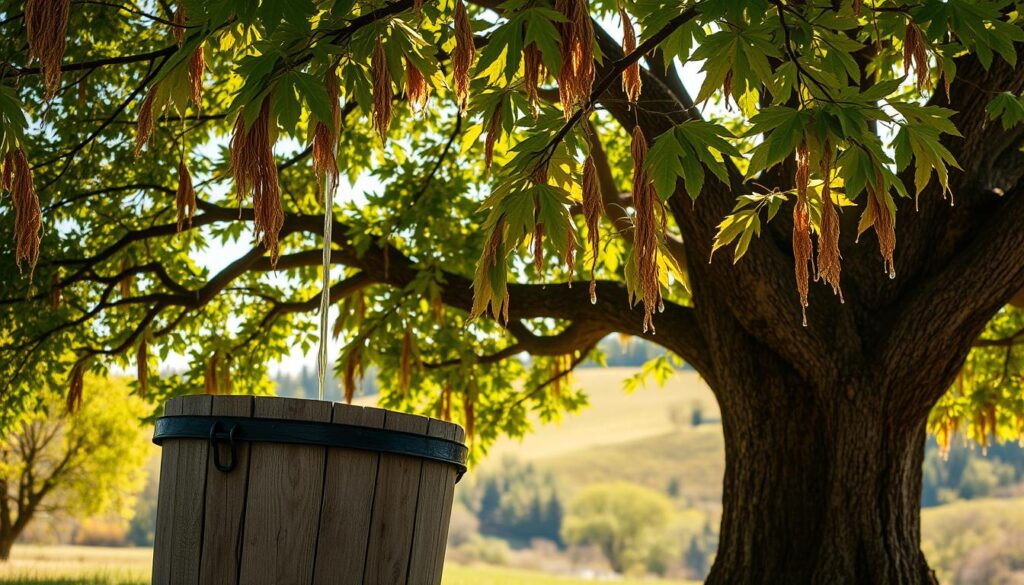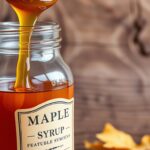The traditional maple syrup bucket is a time-honored way to get nature’s sweet liquid gold. For generations, sugarmakers have used these buckets to get maple sap. They turn raw forest sap into a tasty treat.
A maple syrup bucket is more than a container. It’s a key tool in the sap collection process. Made from strong materials like metal or food-grade plastic, these buckets catch the sap. This sap will become rich, amber syrup.
The art of sap collection starts with placing buckets on the right trees. Skilled sugarmakers know the best bucket spot for quality sap. Each bucket quietly collects the sap, which will change into syrup.
During the sugaring season, these buckets are the center of maple syrup making. They sit on tree trunks, catching sap as temperatures change. This process needs precision, patience, and knowledge of maple trees.
Maple syrup bucket design has changed, but its purpose stays the same. It’s to catch the tree’s natural liquid. Whether metal or plastic, the goal is to get pure, fresh sap. This sap is then boiled down into sweet syrup.
Understanding the Heritage of Maple Sap Collection
Maple syrup production links human culture with natural resourcefulness. It has a long history, showing the blend of indigenous knowledge and innovation. This blend shapes North American food traditions.
Native American Origins of Maple Sugarbush Tools
Indigenous peoples first found the sweet value of maple trees. Their advanced methods for maple syrup production came before European settlers. Native American communities created tools for sap collection and processing.
- Wooden troughs carved from tree trunks
- Stone vessels for sap collection
- Primitive heating techniques using hot stones
Colonial Adaptation and Cultural Transformation
European settlers learned from Native Americans how to collect maple sap. They brought metal tools and containers, changing traditional tools. This change turned maple syrup from a survival need to a business opportunity.
Cultural Significance in North America
Maple syrup production became a key economic and cultural practice. Small communities in northeastern forests built traditions around maple harvesting. These traditions created a shared identity that lasts today.
“Maple syrup is not just a food; it’s a living history of North American agricultural innovation.”
Components of a Traditional Maple Syrup Bucket
Starting to make maple syrup means knowing the key Maple Sugaring Equipment. The traditional bucket system has important parts that work together. They help gather the sweet sap from nature.
The main parts for making syrup include:
- Wooden Bucket: Made from strong pine or cedar, these buckets hold 2-3 gallons of sap
- Metal Spile (Tap): This is put into the maple tree to get the sap
- Protective Lid: Keeps out dirt and rainwater from the sap
- Bucket Hanger: Holds the bucket to the tree at the right angle
Choosing the right materials is key for maple sugaring gear. Wooden buckets keep the sap cool and stop bacteria. The metal spile must be safe and last long, made from stainless steel or aluminum.
Experts in sugarmaking know each part of their Syrup Making Supplies is important. From the spile’s angle to the lid’s fit, every detail counts in collecting sap.
“The right equipment turns sap collection into an art.” – Traditional Maple Syrup Producers
Selecting the Right Maple Trees for Tapping
Choosing the right maple trees is key for successful tapping. Not all maple trees are good for making syrup. Knowing which trees to pick is important for any maple farm.
Starting with the right trees is the first step to making great syrup. There are important things to think about. These things affect how much sap you get and how good it tastes.
Identifying Sugar Maple Species
Sugar maples are the best for syrup. They have a few special features:
- Distinctive five-lobed leaves with smooth edges
- Gray, hard bark with tight vertical ridges
- Bright green leaves that turn vibrant yellow, orange, and red in autumn
Tree Age and Size Requirements
Not every maple tree is ready for tapping. Here are some rules to follow:
| Tree Characteristic | Minimum Requirements |
|---|---|
| Minimum Diameter | 10 inches at chest height |
| Minimum Tree Age | 40 years old |
| Maximum Taps per Tree | 3 taps (depending on tree size) |
Optimal Tapping Locations
Where you tap the tree matters a lot. Experts say to look for:
- Smooth bark surface
- Southern exposure for better sap flow
- Areas away from previous years’ tap holes
“The secret to great maple syrup is respecting the tree and understanding its natural rhythms.” – Vermont Maple Expert
Maple Tree Tapping is both an art and a science. By picking and caring for the right trees, sugarmakers can get sap for years.
Essential Tools for Maple Sap Harvesting
Harvesting maple sap needs the right tools and equipment. Sugarmakers must get their gear ready before the season starts. This ensures they have everything for a smooth harvest.
The main tools for maple sap harvesting are:
- Tapping drill: A special drill bit for making holes in maple trees
- Spiles (taps) for putting into the holes
- Collection buckets with covers
- Hammer for installing spiles gently
- Protective gloves and safety gear
Professional sap harvesting needs precise tools. The right equipment greatly affects how much sap you get and how efficiently you collect it.
Keeping tools in good shape means they last longer and work better all season.
Sugarmakers often choose durable, high-quality tools. These tools can handle many seasons without breaking. Stainless steel parts don’t rust and keep the sap clean, which is key for making great maple syrup.
Knowing how each tool works helps harvesters collect sap better. It also protects the maple trees from damage during tapping.
Proper Installation of Maple Syrup Bucket Systems
Maple tree tapping needs precision and care for a good sap collection. The right maple syrup bucket installation is key for quality and quantity.
Good maple syrup bucket systems need a few important steps. These steps protect the tree and the sap collection.
Drilling Techniques for Optimal Sap Flow
Drilling for maple tree tapping is all about detail:
- Use a sharp drill bit between 7/16 to 5/16 inches in diameter
- Drill at a slight upward angle of about 3-5 degrees
- Create holes 1.5 to 2 inches deep into healthy tree bark
- Ensure the drilling depth does not penetrate more than 2 inches into the tree
Strategic Spout Placement
Choosing the right spot for the spout is key for sap collection. Look for places that:
- Avoid previous tap holes
- Are at least 6 inches from old drilling sites
- Target areas with smooth, healthy bark
- Consider tree diameter for multiple taps
Bucket Hanging Methods
Securing maple syrup buckets right is important:
- Use sturdy metal hooks designed for maple sap buckets
- Ensure buckets are level and firmly attached
- Position buckets to prevent debris contamination
- Check bucket stability during wind or harsh weather
Professional sugarmakers know that careful installation protects both the tree and the precious sap harvest.
Timing the Sugaring Season
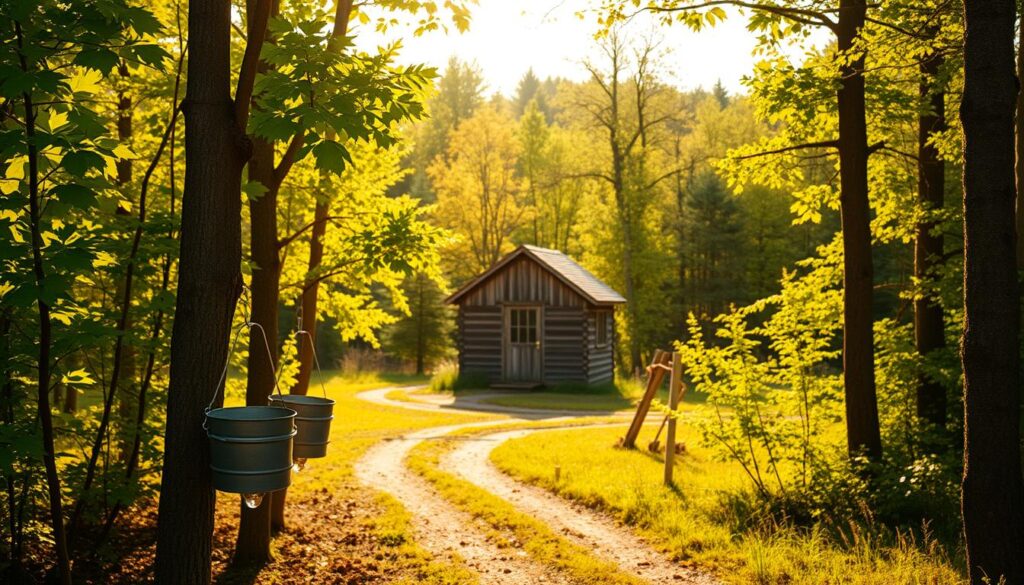
The Sugaring Season is a key time for making maple syrup, lasting from late winter to early spring. Sugarmakers watch the environment closely to find the best time for sap flow. This timing is vital for a good maple syrup harvest.
To make maple syrup well, you need to know when sap moves in maple trees. The best time is when it’s warm during the day (32-40°F) and cold at night.
- Typical Sugaring Season duration: 4-6 weeks
- Peak collection period: February to March
- Geographic variations impact collection timeframes
The climate where you are affects when you can make maple syrup. Places like Vermont and Quebec have longer, more stable seasons. This is different in southern areas.
| Region | Season Start | Season Duration |
|---|---|---|
| Northern New England | Late February | 6-7 weeks |
| Mid-Atlantic States | Early March | 4-5 weeks |
| Midwest | Mid-March | 3-4 weeks |
Seasoned sugarmakers keep an eye on the weather and how trees work. They watch the temperature every day. This helps them catch the best times for sap flow.
Daily Maintenance and Collection Practices
Successful Sap Collection needs careful daily work on maple farm essentials. Sugarmakers know that regular care affects syrup quality and amount. Every step in collecting sap requires precision and watchful eyes.
Keeping a maple syrup operation running well involves key practices. These ensure the best sap harvesting and syrup quality.
Monitoring Sap Flow
It’s vital to track sap flow for Maple Farm Essentials. Sugarmakers should:
- Check buckets often during the busy season
- Use standard containers to measure sap volume
- Keep an eye on temperature changes that affect sap
- Watch tree health and tap condition
Cleaning Procedures
Cleaning is key to avoid contamination and keep sap quality high. Here are some cleaning steps:
- Rinse buckets with hot water after each use
- Use food-grade sanitizers
- Dry equipment well to stop bacteria growth
- Check spouts and taps for damage or blockages
Storage Requirements
Storing sap right is critical to keep it fresh. Fresh sap must be kept cold and processed fast to avoid spoilage. Sugarmakers store sap at 33-38°F to keep its quality until it’s processed.
Common Challenges in Traditional Sap Collection
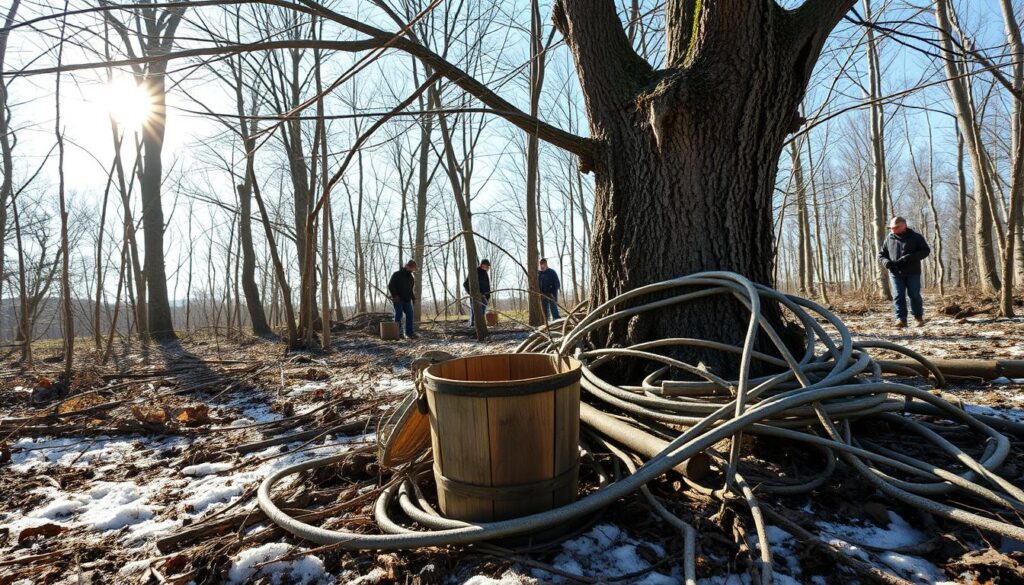
Maple sap harvesting comes with its own set of challenges for those using old methods. The success of Maple Sugarbush Tools relies on tackling these issues head-on.
Weather is a big factor in maple sap harvesting. Changes in temperature can greatly affect sap flow, making it hard to predict when to collect. Sugarmakers need to keep a close eye on the weather to get the most sap.
- Freezing nights and warm days trigger optimal sap movement
- Prolonged cold spells can halt sap production completely
- Unexpected warm periods might reduce overall sap quality
Wildlife can also be a big problem. Animals like raccoons and squirrels might damage the buckets or mess with the equipment.
| Wildlife Challenge | Potential Solution |
|---|---|
| Bucket Damage | Protective metal covers |
| Equipment Tampering | Secure mounting techniques |
| Contamination Risk | Regular cleaning and inspection |
Keeping equipment in good shape is key in Maple Sap Harvesting. Older systems need careful maintenance to avoid leaks and collect sap efficiently. Sugarmakers spend a lot of time making sure their tools are ready for the season.
By being proactive, these challenges can be lessened. Regular checks on equipment, smart bucket placement, and flexible methods can boost sap collection.
Modern Alternatives to Traditional Maple Syrup Bucket Methods
The world of maple syrup production has changed a lot with new technology. Now, there are advanced tools for collecting sap, making the process easier and more efficient.
More sugarmakers are using new supplies to make syrup. These tools help them work better and get more syrup.
Tubing Systems: A Game-Changing Approach
Tubing systems are key in modern sap collection. They use tubes instead of buckets to:
- Save time and effort
- Keep sap flowing all the time
- Keep the sap clean
- Tap more trees
Vacuum Enhancement Techniques
Vacuum technology is another big step forward. It uses negative pressure to:
- Get more sap
- Collect sap faster
- Harvest sap longer
Digital Monitoring Solutions
New syrup making supplies include digital tools. These tools give updates on:
- Sap flow rates
- Temperature changes
- How well the system is working
- Any problems with equipment
These new tools show how maple syrup making is getting better. It’s mixing old ways with new tech.
Maximizing Sap Yield with Proper Bucket Placement
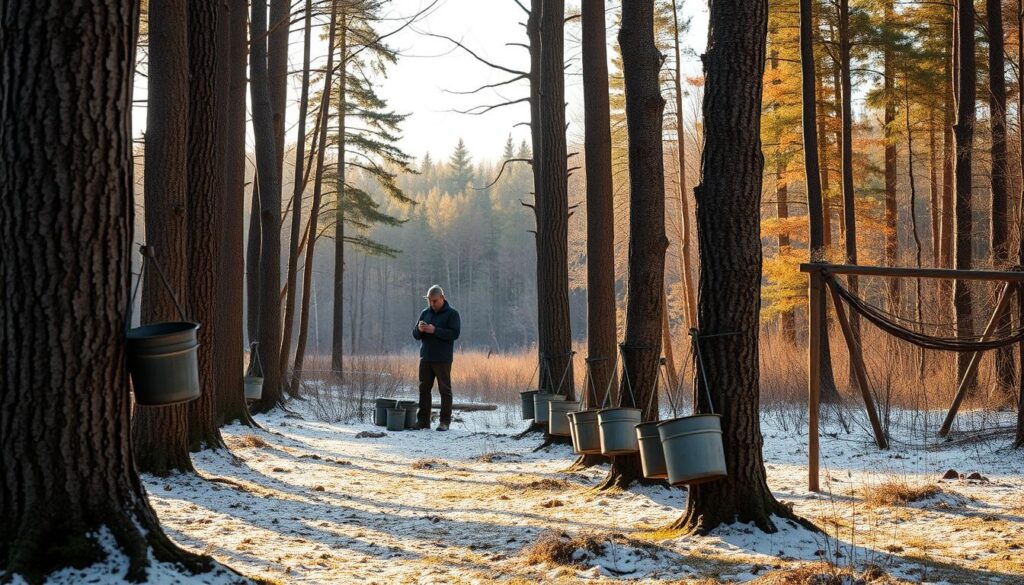
Putting maple syrup buckets in the right spot is key to a good sap harvest. Knowing how to place these buckets can really boost your maple syrup production.
When picking spots for maple syrup buckets, sugarmakers need to think about a few things:
- Tree orientation relative to sunlight exposure
- Protection from wind interference
- Slope and terrain characteristics
- Proximity to other tapped trees
The best sap collection starts with trees that get morning sun. South-facing slopes are usually best for sap flow. Trees that warm up slowly will have sap moving faster.
Choosing the right spot for maple syrup buckets is all about knowing the sugarbush’s microclimates. Places that stay warm but not too hot can help collect sap longer. Sugarmakers should move and adjust their buckets to get the most sap all season.
Experienced maple producers know that bucket placement is as much an art as it is a science.
Keeping sap collection steady is important. Buckets should be on trees that block wind, so sap flow isn’t messed up by quick temperature changes.
- Avoid northern-facing slopes with limited sunlight
- Select trees with minimal branch interference
- Ensure easy access for regular collection
Using these smart placement tips, maple syrup makers can get more sap and improve their harvest.
Storage and Off-Season Care of Collection Equipment
Keeping Maple Sugaring Equipment in good shape is key for a long-lasting performance. It’s important to take care of Maple Farm Essentials during the off-season. This prevents damage and keeps them in top condition.
Sugarmakers know the off-season is a critical time for equipment care. Proper preparation can greatly improve future maple syrup production’s efficiency and quality.
Comprehensive Cleaning Protocols
Cleaning maple syrup collection tools requires several important steps:
- Thoroughly rinse all Maple Sugaring Equipment with hot water
- Use specialized food-grade sanitizing solutions
- Scrub buckets and spouts to remove any sap residue
- Dry equipment completely to prevent mold growth
Optimal Storage Conditions
Storing Maple Farm Essentials correctly is essential:
- Store equipment in a cool, dry environment
- Use protective covers to prevent dust accumulation
- Hang buckets to maintain their shape
- Keep metal components in a humidity-controlled space
Seasonal Maintenance Schedule
A structured maintenance plan keeps equipment in top shape:
- Early Summer: Deep cleaning and initial inspection
- Late Summer: Repair any damaged components
- Fall: Complete equipment assessment
- Winter: Prepare and organize for next season
By sticking to these guidelines, sugarmakers can safeguard their valuable maple syrup equipment. This ensures they’re ready for another successful season.
Environmental Impact and Sustainable Practices
Maple tree tapping is a careful mix of human action and nature’s protection. Sugarmakers aim to keep forests healthy while getting maple sap. They use old methods that help the environment by managing trees well.
When using maple sugarbush tools, it’s important to think about the environment:
- Minimal tree impact during Maple Tree Tapping
- Protection of forest biodiversity
- Preservation of maple tree long-term health
- Ecosystem conservation strategies
Good practices mean picking the right trees and tapping them wisely. Experienced sugarmakers tap trees only when they’re big enough, usually over 10 inches. This way, they don’t harm young trees and get the most sap.
Traditional maple syrup making does more than just help trees. It also helps with carbon capture, animal homes, and keeps the area’s balance. Sugarmakers show they care about growing food in a way that’s good for the planet.
“Sustainable maple syrup production is not just about harvesting – it’s about nurturing entire forest ecosystems.” – Maple Forest Conservation Alliance
New tools for maple sugarbush have made things better for the environment. Better spiles make smaller wounds, help trees heal faster, and stop infections. These changes show a big effort to care for nature’s resources.
Economic Benefits of Traditional Collection Methods
Traditional maple syrup production has big economic perks for small-scale makers and hobbyists. The cost to start with bucket collection is much lower than with modern tech.
Maple Syrup Production by bucket systems brings many economic benefits:
- Low startup costs for new producers
- Minimal equipment needed
- Direct sales to customers
- Higher prices for specialty syrup
Small producers can use the charm of traditional methods. Handcrafted maple syrup gets higher prices at farmers markets, specialty stores, and online.
The economic model for traditional syrup collection includes:
- Initial equipment cost under $500
- Little ongoing maintenance costs
- Annual income of $1,000-$5,000
- Flexibility for part-time or seasonal work
Rural areas and family farms gain a lot from these traditional methods. The low start-up cost lets people earn extra money. They also keep cultural heritage and sustainable farming alive.
“Traditional maple syrup production isn’t just about making syrup—it’s about maintaining a connection to generations of agricultural craftsmanship.”
Conclusion
Maple sap harvesting is more than making sweet syrup. It’s a tradition that connects families across North America. Using traditional buckets to collect sap keeps the sugaring season real.
Today, we have new ways like tubing systems and digital tools. But, the basics of picking the right trees, tapping them right, and being green are the same. It’s all about finding the right mix of old and new.
Learning about sap collection teaches us a lot. It shows us the skill in traditional methods. This helps us connect with this special farming tradition.
Whether you make syrup for fun or for a living, it’s a journey worth taking. It shows us the beauty of a tradition that adds sweetness to our lives.

